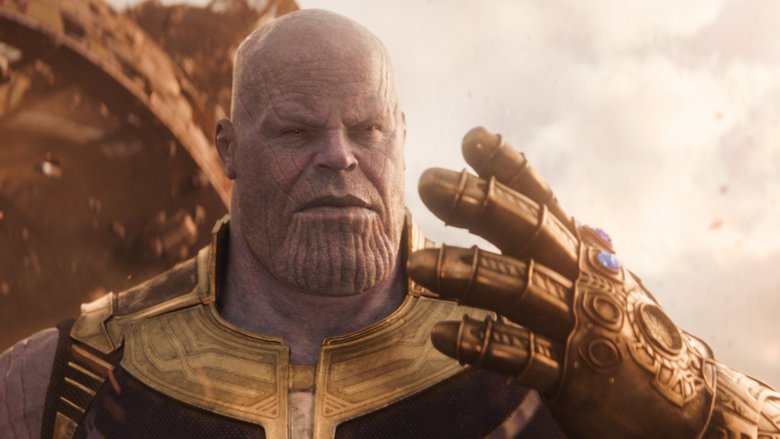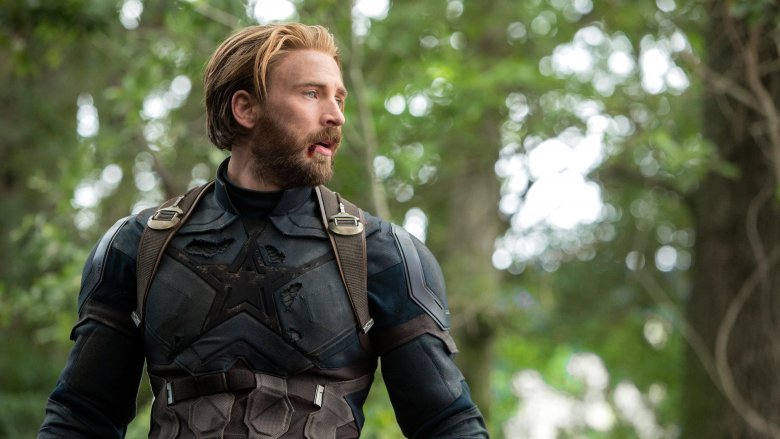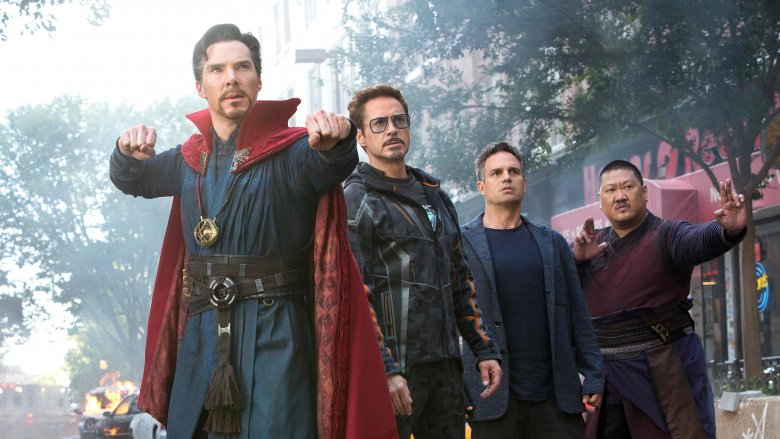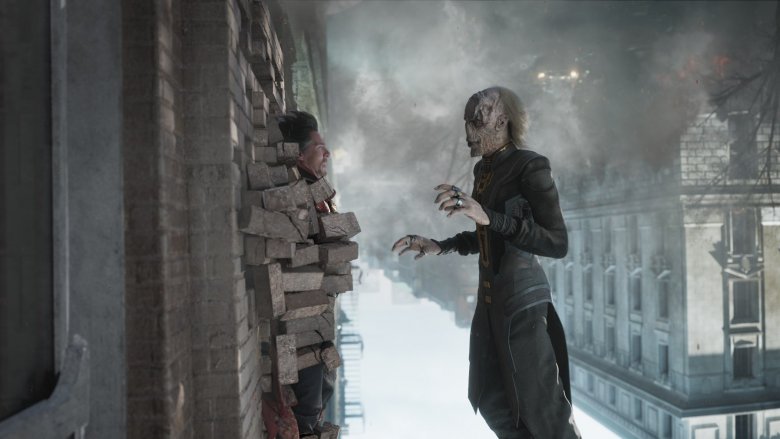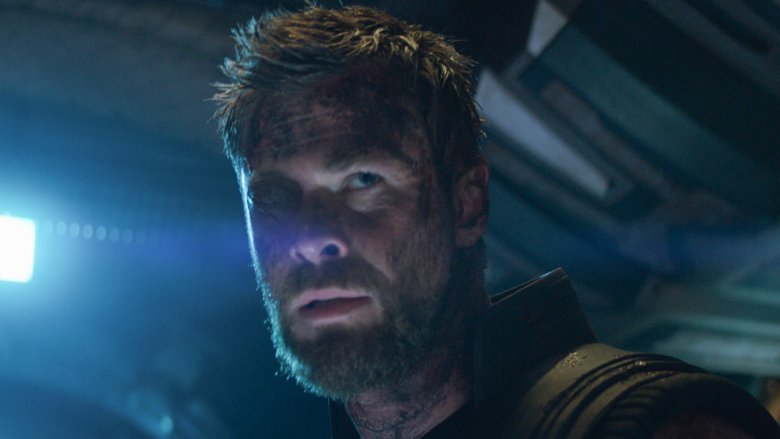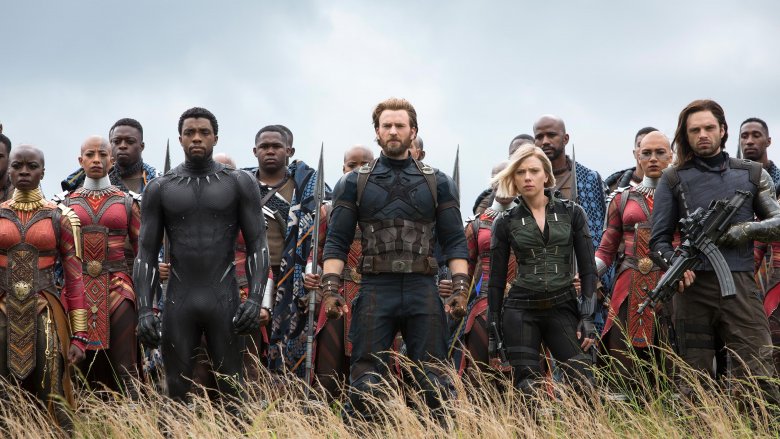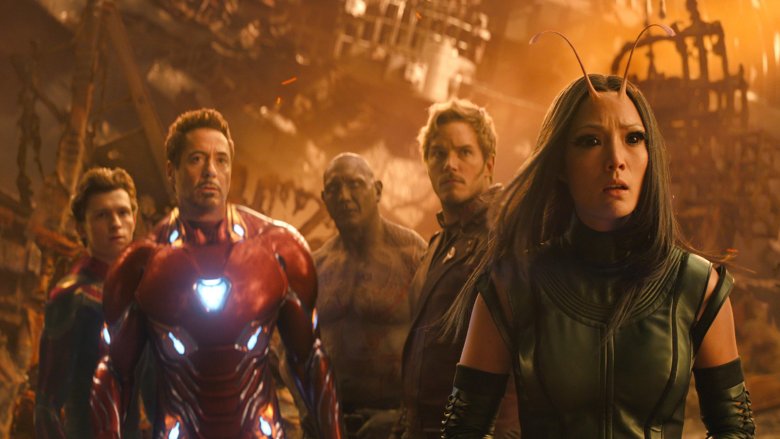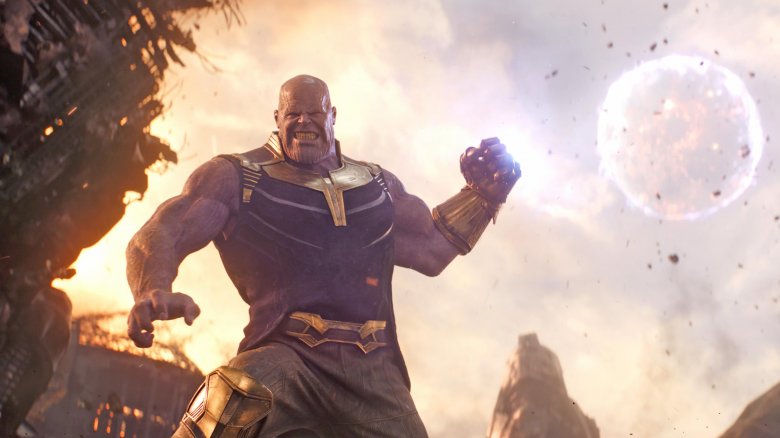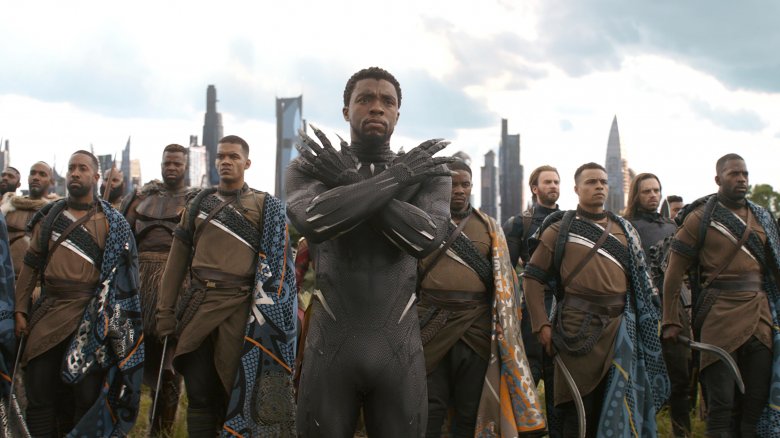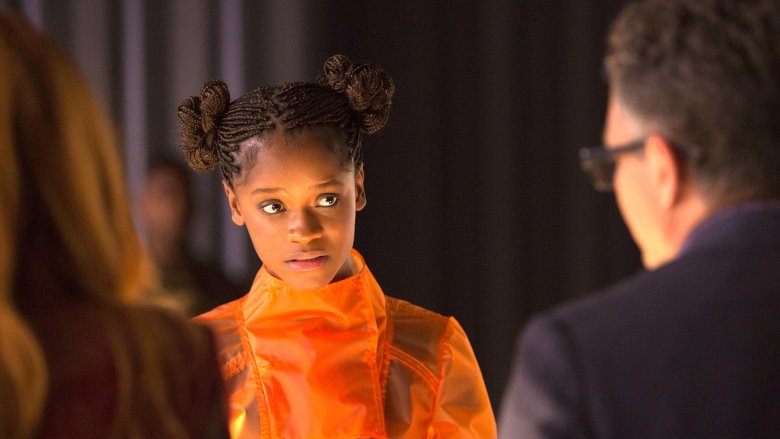The Untold Truth Of Avengers: Infinity War
Avengers: Infinity War conquered the box office after its April 2018 premiere, and now that the movie has arrived on home video, fans around the world can pore over every action-packed minute again and again to absorb as many details as possible — along with a bevy of new special features to provide us even more insight into the making of the most epic Marvel movie ever.
We've talked about the ending, all the unanswered questions, the small details, the things only adults notice, the hidden meanings, the best and worst lines, and even the massive body count. Now it's time to look into everything that went into crafting this blockbuster, from the scale of the production to the long writing process to an improvised line or two. If you still can't get enough of Earth's Mightiest Heroes squaring off against Thanos, get ready for the untold truth of Avengers: Infinity War.
A constantly changing script
According to writers Christopher Markus and Stephen McFeely, work on the Infinity War script started around January of 2016. They went through "several iterations" before arriving at what we saw, including versions written well before Thor: Ragnarok and Black Panther — both films with a heavy influence on the MCU leading into Infinity War — were completed. That meant a lot of changes had to be made, ranging from small omissions to big structural shifts. Throughout the commentary track and in interviews, Markus and McFeely have noted several: Howard the Duck was originally in a scene, there was at one time much more of Thor bantering with the Guardians of the Galaxy, early drafts included more backstory for the Black Order, and we almost saw the destruction of Xandar and Thanos obtaining the Power Stone. Perhaps the most intriguing of these changes, though, came with the character of Captain America, whose role was already quite limited. Markus and McFeely note that one version of the film had him not showing up until he saved Vision from Corvus Glaive in Wakanda — good thing they changed their minds on that one.
An epic production
Avengers: Infinity War spans multiple planets, several continents on our planet, and features dozens of speaking roles as well as truly massive set pieces that take us from Wakanda to Titan. It stands to reason, then, that the production would be nothing short of massive — and the numbers don't disappoint. According to co-director Joe Russo in the featurette Beyond The Battle: Wakanda, more than 6,000 people worked on the film at one point or another, all collaborating to create what producer Victoria Alonso estimated to be more than 3,000 shots. Of those 3,000 shots, 2,900 of them required some form of visual effects in post-production, which meant that a portion of the Infinity War team had to add something to just about every second of the film. Think about it — and then consider that every one of those people had to be paid, fed, and often even housed — and you get an idea of how gargantuan this film was.
A diverse range of influences
The original Marvel Comics that delivered much of the basis for its characters and story were obviously major influences on Avengers: Infinity War's storytelling decisions, but they weren't the only ones. Director Joe and Anthony Russo are, of course, cinematic thinkers, and a number of different films were referenced or listed as influences for Infinity War. On the film's commentary track, two key moments — when Ebony Maw tries to grab Doctor Strange's amulet and when Maw is sucked into space — are highlighted as nods to Steven Spielberg's Raiders of the Lost Ark, while the moment when Maw is torturing Strange with needles is a nod to Marathon Man. In interviews for the film, the Russos also highlighted various crime films as influences on Infinity War's heist-like elements, including Out of Sight and Two Days in the Valley.
A few striking cameos
Since this is a Marvel Studios movie, we all expected to see a few cameos in Infinity War — and we got them, though they weren't always in the most obvious places. The really obvious appearance, of course, was the traditional cameo from Marvel legend Stan Lee, who appeared as the bus driver when Peter Parker sneaks away from a field trip to go help Iron Man. A more subtle cameo comes with the very first voice we hear in the film, sending out a distress signal for Thor and Loki's Asgardian refugee ship. That's Kenneth Branagh, the director of Thor, who the Russos noted on the commentary track was able to come in late in the production and record the lines. Then there's a more bizarre appearance: In the scene on Knowhere, a blue-skinned man wearing glasses, a mustache, and cutoff shorts can be seen in one of The Collector's display cases. That's a nod to Tobias Fünke, a character from the TV series Arrested Development, which the Russo brothers worked on.
A stand-in for Wakanda
Much of Avengers: Infinity War's final act takes place in a field in the fictional African nation of Wakanda, where a massive battle is waged between the Avengers, their Wakandan allies, and Thanos' army of alien Outriders. Of course, since Wakanda is fictional, the crew couldn't film there, but they also couldn't film in Africa, so instead a ranch just outside of Atlanta (where much of the movie was filmed) had to be a stand-in for the kingdom of the Black Panther. That meant, according to the Beyond the Battle: Wakanda featurette, building an artificial river that pumped 30,000 gallons a minute across the battlefield, dressing the location with plant life native to Africa, and hiring 70 extras (later multiplied digitally) to serve as the Wakandan army. To make matters more complicated, the crew was also constantly battling rain storms, which meant numerous days during which the field was covered in mud and unusable.
Grim revelations on the set
The level of secrecy on any Marvel Studios production is incredible, but it was particularly high for Infinity War, a film now infamous for a crushing ending that even fans who expected some loss of life never saw coming. The decision to allow Thanos to snap his fingers and eradicate half of all life in the universe meant losing a large number of Avengers, and that meant a large number of actors eventually had to be told who lived and who died. According to executive producer Trinh Tran in Beyond the Battle: Wakanda, this was put off as long as possible. It wasn't until the morning of that day's shooting that the cast gathered around the Russo brothers and they were told who would be fading away after the snap and who would survive. Each "dying" cast member had to quickly prepare for their death scene — however permanent it may or may not turn out to be.
Which stone did the deed?
The Russo brothers have frequently described Avengers: Infinity War as Thanos' journey, and in addition to watching the sacrifices and compromises he makes on his way to getting each Infinity Stone, we also watch him grow more powerful with each acquisition, setting up moments at the end of the film when he's basically doing whatever he wants, whenever he wants with the various stones in his possession. The near all-powerful Thanos still needed detail applied to everything he was doing, though, and that meant the filmmakers kept track of which stone the Mad Titan was using to achieve each individual task in the film. For example, the Russos and Markus and McFeely note on the commentary track that, for the scene in which he throws a moon at Iron Man, Thanos is using the Power Stone to break the moon apart and then using the Space Stone to pull it down to Titan. In an interview given after the film's release, visual effects supervisor Dan DeLeeuw also revealed that it's the Power Stone doing most of the heavy lifting during the infamous snap, and that's what causes the characters to turn to dust.
Room for improvisation
Infinity War is massive, and it required incredible amounts of planning and structuring in order to properly execute onscreen. Even with all that in mind, though, the filmmakers still found room for improvisation and new additions, and some of those come during crucial moments. On the commentary track, the writers and directors note that when Thanos is subdued by the Avengers and Guardians on Titan, Star-Lord's brag that "For the record, this was my plan" was all Chris Pratt. In Beyond the Battle: Wakanda and on the commentary track, the filmmakers note that the Black Panther cast, whose film had not yet come out, were performing the Wakandan war chants off camera as a way to warm themselves up for the action. The Russos heard the chants and decided to incorporate them into the film. Not all of the new additions came from the cast, though. On the commentary track, the filmmakers note that Rocket referring to the Outriders as "space dogs" came from one viewer who called the creatures that name during a focus group discussion after an early test screening. They thought it was funny, and added it to Bradley Cooper's dialogue for his Rocket recording sessions.
Other casualties, other survivors
Avengers: Infinity War ends with one of the most massive gut punches in cinematic history, as a montage spanning two planets shows us the deaths of numerous Marvel favorites, including Spider-Man, Star-Lord, Scarlet Witch, Black Panther, and eventually even Nick Fury. It's a huge loss, but it's only a tiny portion of the devastation Thanos brought with his snap. Remember, we're talking about half of all life in the universe here, which means half of anyone you've ever seen and loved (or hated) in an MCU film. With that in mind, the filmmakers also made sure to keep track of which characters survived and disintegrated offscreen, including those who weren't even in Infinity War. On the "survived" side, we have Howard the Duck, Spider-Man's Aunt May, and probably Shuri and Nakia from Wakanda (though the Russos wouldn't say for sure in interviews immediately after the film's release). On the "deceased" side, there's Incredible Hulk co-star Betty Ross, the Asgardian Lady Sif, and — as we later learned thanks to Ant-Man and the Wasp — Janet van Dyne, Hope van Dyne, and Hank Pym. Of course, this is Marvel we're talking about, so there are also some characters whose fates remain unknown to anyone but the writers.
